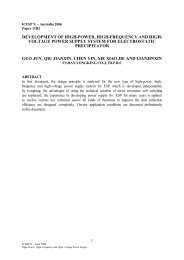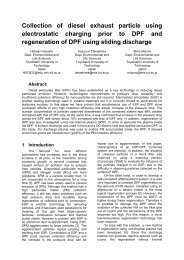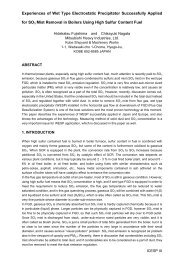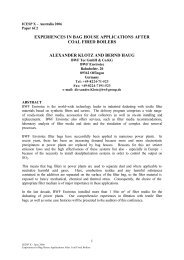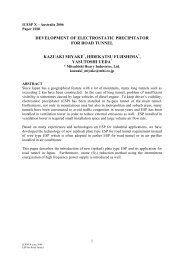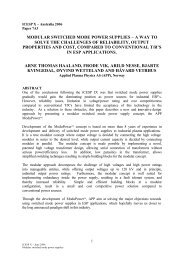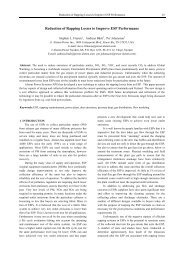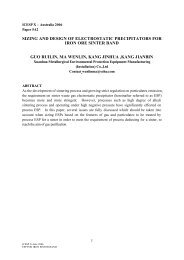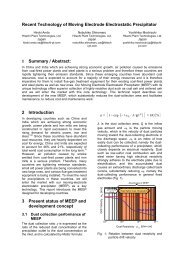Electrostatic precipitator performance in indian pulverized coal - isesp
Electrostatic precipitator performance in indian pulverized coal - isesp
Electrostatic precipitator performance in indian pulverized coal - isesp
You also want an ePaper? Increase the reach of your titles
YUMPU automatically turns print PDFs into web optimized ePapers that Google loves.
Effect of Sulphur Content <strong>in</strong> Coal on Fly Ash Resistivity<br />
The major contribution of ash resistivity depends on the content of sulphur <strong>in</strong> <strong>coal</strong><br />
(Bickelhaupt, 1978). It was observed that resistivity / conductance of ash ma<strong>in</strong>ly depends on<br />
the follow<strong>in</strong>g factors:<br />
i) Forms of sulphur (organic, pyretic & sulphate sulphur)<br />
ii) Organic sulphur has more potential to reduce ash resistuvity than pyretic or sulphate<br />
sulphur <strong>in</strong> the <strong>pulverized</strong> <strong>coal</strong> fired boiler.<br />
iii) Availability of SO 3 <strong>in</strong> flue gas rather than sulphur content <strong>in</strong> <strong>coal</strong>.<br />
iv) Rate of conversion of SO 2 to SO 3 .<br />
v) Presence of other SO 3 absorb<strong>in</strong>g chemicals like alkalis and calcium content <strong>in</strong> fly ash.<br />
The orig<strong>in</strong> of three forms of sulphur <strong>in</strong> <strong>coal</strong> is available <strong>in</strong> the literature<br />
(Mandal,2003).Dur<strong>in</strong>g burn<strong>in</strong>g of <strong>pulverized</strong> <strong>coal</strong> <strong>in</strong> the furnace the organic sulphur present<br />
<strong>in</strong> <strong>coal</strong> gets evolved at higher temperature and generally burns at upper layer of the furnace<br />
and get entry <strong>in</strong>to flue gas. On the other hand, sulphur present <strong>in</strong> m<strong>in</strong>eral part of <strong>coal</strong> (e.g.<br />
pyritic, FeS2 and sulphate sulphur, CaSO 4 .2H 2 O) decompose at early stage of combustion at<br />
relatively lower temperature which is further lowered at reduc<strong>in</strong>g atmosphere and get entry<br />
<strong>in</strong>to the bottom part of the furnace. Coal used <strong>in</strong> the present study is of low sulphur <strong>coal</strong> and<br />
major share comes from organic sulphur <strong>in</strong> total sulphur content. The total and different<br />
forms of sulphur <strong>in</strong> <strong>coal</strong>s<br />
(Coal - a to Coal - g) are given <strong>in</strong> Table 5.<br />
Table 5: Total sulphur and different forms sulphur (wt%, air dry basis).<br />
___________________________________________________________________<br />
Sample Total Sulphur Pyritic Sulphur Sulphate Sulphur Organic Sulphur<br />
___________________________________________________________________<br />
Coal-a 0.39 0.070 0.004 0.316<br />
Coal-b 0.73 0.110 0.038 0.600<br />
Coal-c 0.63 0.094 0.013 0.523<br />
Coal-d 0.68 0.051 0.012 0.617<br />
Coal-e 0.58 0.080 0.009 0.491<br />
Coal-f 0.42 0.082 0.019 0.319<br />
Coal-g 0.36 0.120 0.040 0.200<br />
___________________________________________________________________<br />
By comparison of Data of Table 2, Table 3 & Table 4 it was observed that the resistivity<br />
values varied accord<strong>in</strong>g to the values of sulphur content especially organic sulphur.<br />
REMEDIAL MEASURES<br />
The <strong>coal</strong>s used <strong>in</strong> Indian power stations are generally non-cok<strong>in</strong>g low sulphur and alkali<br />
content <strong>coal</strong>s. The total silica and alum<strong>in</strong>a content is more than 90% mak<strong>in</strong>g the ash high<br />
resistivity ash. The problem become many fold due to low heat value and high ash <strong>coal</strong> which<br />
demand higher <strong>coal</strong> feed<strong>in</strong>g and result<strong>in</strong>g very high ash load<strong>in</strong>g on ESP. Another source of<br />
problems is <strong>in</strong> design<strong>in</strong>g of PC f<strong>in</strong>eness which is not as per <strong>coal</strong> reactivity and not<br />
ma<strong>in</strong>ta<strong>in</strong><strong>in</strong>g the f<strong>in</strong>eness level <strong>in</strong> many power stations lead<strong>in</strong>g to very f<strong>in</strong>e PC and get entry <strong>in</strong><br />
the furnace with generation of sub-size ash particles. In some of the stations it was found that<br />
more than 35% of ash particles are below 10 µm. F<strong>in</strong>eness has tremendous effect on ESP<br />
<strong>performance</strong>. The effect of f<strong>in</strong>eness on ESP ash collection is given <strong>in</strong> Fig. 5.<br />
ICESP X – June 2006<br />
Indian Power Stations - Problems and Solutions<br />
7



